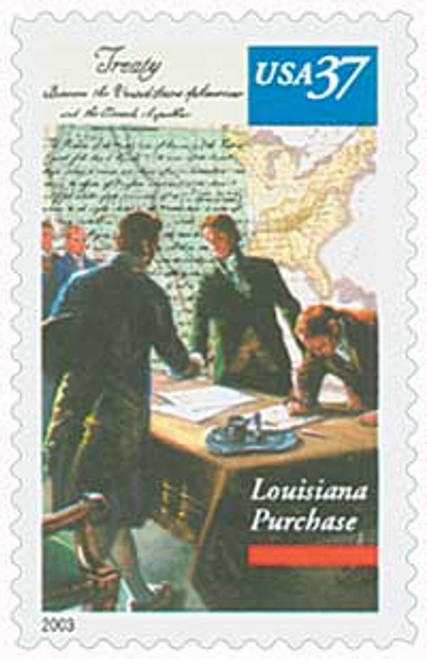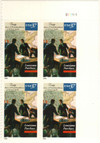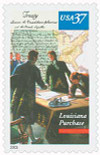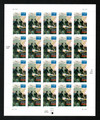
# 3782 - 2003 37c Louisiana Purchase Bicentennial
37¢ Louisiana Purchase Bicentennial
City: New Orleans, Louisiana
Quantity: 54,000,000
Printed By: American Packaging Corporation for Sennett Security Products
Printing Method: Photogravure
Perforations: Serpentine Die Cut 10 ¾
Color: Multicolored
Three Flags Day

On March 10, 1804, the US flag was raised over St. Louis, marking the completion of the Louisiana Purchase. This day, along with March 9, is known as Three Flags Day.
In the early 1800s, Napoleon Bonaparte sought to create a great French empire in the New World. The center of the empire was to be the nation of Hispaniola. Napoleon envisioned that the Mississippi Valley would be the trade center of the new empire, shipping food and supplies from America to Hispaniola.

At this time, Hispaniola was in the midst of a slave revolt. This revolt had to be put down before French control could be restored. In an attempt to end it, Napoleon sent a large army to Hispaniola. Although there were considerable French victories on the battlefield, many soldiers died from disease. Because of these heavy losses, Napoleon decided to abandon Hispaniola and, in turn, his dream of an empire in the New World.
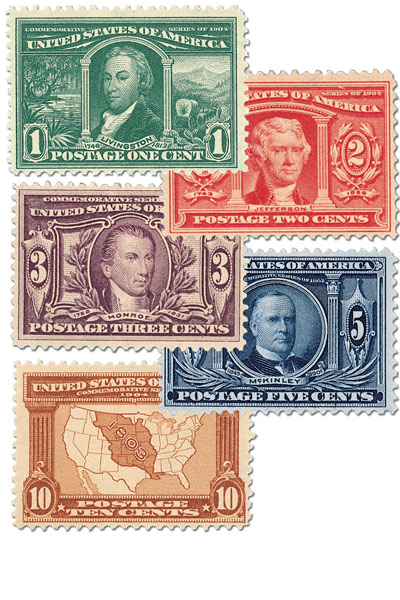
With Hispaniola gone, Napoleon had little use for Louisiana. Additionally, war was imminent in Europe and he couldn’t spare troops to defend the territory. This caused Napoleon to offer the land for sale to the United States, which had expressed interest in New Orleans.
Commerce in the US depended heavily on waterways during the early 1800s. None was more important to US interests than the mighty Mississippi River and the port city of New Orleans. Fearful that the US might lose navigational rights along the Mississippi, President Thomas Jefferson sent James Monroe and Robert R. Livingston to Paris to negotiate the purchase of New Orleans and its immediate surrounding area. Jefferson also sent Pierre Samuel du Pont de Nemours, a French nobleman living in the United States. He had political connections in France, so Jefferson asked him to help with negotiations.
Monroe and Livingston were prepared to offer $10 million for the port city, but France offered the entire 530-million-acre area for $15 million. Concerned Napoleon would withdraw the offer at any time, the representatives agreed without consulting the president, and the treaty was signed on April 30, 1803.

The purchase was the American government’s largest financial transaction to date, and it doubled the size of the United States at a cost of less than 3¢ per acre. Control of the Mississippi River and the port of New Orleans provided a convenient method of transportation necessary for the development of the new region. The acquisition also distanced France from the young nation, removing the risk that the two like-minded countries would become enemies over conflicting interests.

In spite of the bargain price, the purchase caused controversy. President Jefferson himself questioned whether he had the authority under the US Constitution to acquire land. The issue was so divisive, a group of northerners considered forming a separate northern confederacy. When Napoleon signed the Louisiana Purchase, he said, “This accession of territory affirms forever the power of the United States.” America did grow into a world power, as he predicted.

While the agreement had been reached, the US was unable to immediately take possession of the land. Though Spain had ceded land to France in 1800, their treaty had been kept secret and Spain continued to administer the territory. The land still needed to be formally turned over to France. It would be nearly a year before this was completed, following a series of formal ceremonies.

The first came on November 30, 1803, when Spain transferred New Orleans to France. Then on December 20, New Orleans and the rest of Louisiana were transferred to the US. Finally, on March 9, 1804, the transfer began in St. Louis. The Spanish flag was lowered and the French flag hoisted. It would fly for 24 hours before being removed and replaced by the American flag. The event is often called Three Flags Day and it officially cleared the way for Lewis and Clark to begin their expedition westward.
37¢ Louisiana Purchase Bicentennial
City: New Orleans, Louisiana
Quantity: 54,000,000
Printed By: American Packaging Corporation for Sennett Security Products
Printing Method: Photogravure
Perforations: Serpentine Die Cut 10 ¾
Color: Multicolored
Three Flags Day

On March 10, 1804, the US flag was raised over St. Louis, marking the completion of the Louisiana Purchase. This day, along with March 9, is known as Three Flags Day.
In the early 1800s, Napoleon Bonaparte sought to create a great French empire in the New World. The center of the empire was to be the nation of Hispaniola. Napoleon envisioned that the Mississippi Valley would be the trade center of the new empire, shipping food and supplies from America to Hispaniola.

At this time, Hispaniola was in the midst of a slave revolt. This revolt had to be put down before French control could be restored. In an attempt to end it, Napoleon sent a large army to Hispaniola. Although there were considerable French victories on the battlefield, many soldiers died from disease. Because of these heavy losses, Napoleon decided to abandon Hispaniola and, in turn, his dream of an empire in the New World.

With Hispaniola gone, Napoleon had little use for Louisiana. Additionally, war was imminent in Europe and he couldn’t spare troops to defend the territory. This caused Napoleon to offer the land for sale to the United States, which had expressed interest in New Orleans.
Commerce in the US depended heavily on waterways during the early 1800s. None was more important to US interests than the mighty Mississippi River and the port city of New Orleans. Fearful that the US might lose navigational rights along the Mississippi, President Thomas Jefferson sent James Monroe and Robert R. Livingston to Paris to negotiate the purchase of New Orleans and its immediate surrounding area. Jefferson also sent Pierre Samuel du Pont de Nemours, a French nobleman living in the United States. He had political connections in France, so Jefferson asked him to help with negotiations.
Monroe and Livingston were prepared to offer $10 million for the port city, but France offered the entire 530-million-acre area for $15 million. Concerned Napoleon would withdraw the offer at any time, the representatives agreed without consulting the president, and the treaty was signed on April 30, 1803.

The purchase was the American government’s largest financial transaction to date, and it doubled the size of the United States at a cost of less than 3¢ per acre. Control of the Mississippi River and the port of New Orleans provided a convenient method of transportation necessary for the development of the new region. The acquisition also distanced France from the young nation, removing the risk that the two like-minded countries would become enemies over conflicting interests.

In spite of the bargain price, the purchase caused controversy. President Jefferson himself questioned whether he had the authority under the US Constitution to acquire land. The issue was so divisive, a group of northerners considered forming a separate northern confederacy. When Napoleon signed the Louisiana Purchase, he said, “This accession of territory affirms forever the power of the United States.” America did grow into a world power, as he predicted.

While the agreement had been reached, the US was unable to immediately take possession of the land. Though Spain had ceded land to France in 1800, their treaty had been kept secret and Spain continued to administer the territory. The land still needed to be formally turned over to France. It would be nearly a year before this was completed, following a series of formal ceremonies.

The first came on November 30, 1803, when Spain transferred New Orleans to France. Then on December 20, New Orleans and the rest of Louisiana were transferred to the US. Finally, on March 9, 1804, the transfer began in St. Louis. The Spanish flag was lowered and the French flag hoisted. It would fly for 24 hours before being removed and replaced by the American flag. The event is often called Three Flags Day and it officially cleared the way for Lewis and Clark to begin their expedition westward.

